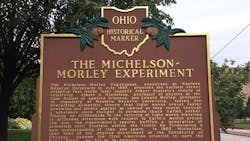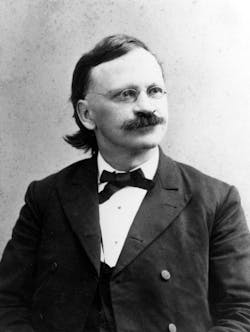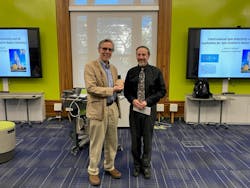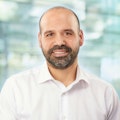CLEVELAND -- I get nostalgic whenever I walk through Case Western Reserve University's (CWRU) campus in Cleveland. I have family roots in the old neighborhoods surrounding the college – Glenville, Cleveland Heights, East Cleveland.
Walking along Euclid Avenue or Bellflower, I imagine roads crisscrossed by streetcars in the early 1900s and the jazz or folk clubs of the 1960s, like La Cave, a frequent stop for the Velvet Underground. Prior to closing in 2016, I spent countless summer nights at the Barking Spider Tavern, a rustic bar near campus known for its acoustic folk performances.
My fondness for the area and its historical significance piqued my interest in Edward W. Morley. I first learned about Morley at a local chapter meeting for the American Chemical Society. Before the meeting, a member told me that Morley was the first chairman of the ACS Cleveland Local Section. He also mentioned that Morley was known as the partner in the famed Michelson-Morley experiment. Renowned astrophysicist Neil deGrasse Tyson referred to the partners' research as "an experimental advance in technology that transformed science, not only physics but science (see YouTube video below).
The experiment took place at Western Reserve University, which later merged with the neighboring Case Institute of Technology to form CWRU.
In 1887, Morley and Albert Michelson, a professor of physics at Case, conducted an experiment to detect Earth's motion through a hypothetical "luminiferous aether" using Michelson's interferometer. The experiment's unexpected result—that two light beams arrived simultaneously at the detector—refuted the ether theory and possibly influenced Einstein's theory of relativity. While Michelson won the Nobel Prize in Physics in 1907 for his optical instruments, including his interferometer, Morley didn't share the honor.
So why didn’t Morley win the Nobel Prize along with Michelson? My interest grew even more when I received an invitation to the annual Morley Medal ceremony hosted by ACS Cleveland. The honoree this year was David Waldeck, who teaches chemistry at the University of Pittsburgh. The ACS chapter recognized Waldeck for his work on chiral-induced spin selectivity, or CISS.
Waldeck and his co-authors described CISS in a 2020 research paper as “the preferential transmission (or transfer) of electrons with one spin orientation over the other through chiral molecules and materials.”
Chiral nanomaterials show promise for applications in the fields of optoelectronics and spintronics, among others.
I have to be honest: Waldeck’s presentation was way over my head. I’m not a chemist, and I was out of my league with this erudite bunch.
Yet, this experience reminded me of the critical role chemists play in our industry. Their breakthroughs are the unsung heroes behind our industry's advancements—yielding materials that are tougher, more resilient and sustainable. So, back to my earlier question: Why didn’t Morley win the Nobel Prize along with Michelson?
I looked for the answers in a book called “Why Edward Morley Didn’t Win The Nobel Prize in Physics.” After reading approximately 35 pages of the book, I began to have doubts about the authenticity of the conversations between Michelson and Morley as presented by the author. Sure enough, on the copyright page, the author stated that “the story is pure fiction.”
So I turned to a local ACS member who recently read a biography written in 1957 about Morley. The ACS member, who preferred to remain anonymous, could only speculate that the two partners’ differing backgrounds may have played a role. Michelson was a PhD physicist, while Morley, originally aspiring to be a minister, had only a bachelor's degree in chemistry. Despite Morley's technical skills and mathematical ability, his lower academic status might have prompted Michelson to distance himself to secure the Nobel Prize alone.
After the Morley Award meeting and dinner, which was held at the Michelson and Morley Restaurant at CWRU, I walked toward Adelbert Hall where the historic experiment took place. Outside the building is an Ohio Historical Marker commemorating the event. I found myself once again envisioning life on these very streets in the late 19th century and picturing the appearance of the basement laboratory where their historic work took place.
I wanted to know more, so I asked Mark Waner, chair of the ACS Cleveland chapter, if he could share any additional information he had about Morley and his work. The next day, he emailed copies of various historical documents, including Morley’s 1923 obituary published in the Journal of the Chemical Society, Transaction.
The obit noted Morley’s work to determine the atomic weight of oxygen.
Morley’s work on the atomic weight of oxygen, that of hydrogen being taken as unity, covered a period of eleven years. Much time was spent in the detection of constant errors, in working out the details of his methods, in the careful calibration of his instruments, and in making ‘‘assurance doubly sure ” as to the purity of his materials. No precaution was overlooked, for the highest possible degree of accuracy was his aim.
Morley also taught geology and botany at Western Reserve University and published more than 55 scientific papers. His obit closed with the following:
Morley was thoroughly human and very modest. He had no affectations, and was not addicted to blowing his own trumpet. He was a charming friend, as the present writer can affirm after more than forty years of personal acquaintance. My conferences with him were always profitable to me.
Morley outlived his wife by only a few months, and died, following a surgical operation, in the Hartford Hospital, at the age of eighty – Frank Wigglesworth Clarke
While he didn’t win the “big prize,” Morley’s achievements are no less remarkable and continue to be recognized. Like Alfred Nobel, a fellow chemist, Morley has an award in his name that, since 1965, has recognized outstanding contributions to chemistry.
For more information on the Edward W. Morley Medal, visit https://www.acscleveland.org/2023/08/call-for-nominations-the-2024-edward-w-morley-medal-of-the-cleveland-section.
About the Author
Jonathan Katz
Executive Editor
Jonathan Katz, executive editor, brings nearly two decades of experience as a B2B journalist to Chemical Processing magazine. He has expertise on a wide range of industrial topics. Jon previously served as the managing editor for IndustryWeek magazine and, most recently, as a freelance writer specializing in content marketing for the manufacturing sector.
His knowledge areas include industrial safety, environmental compliance/sustainability, lean manufacturing/continuous improvement, Industry 4.0/automation and many other topics of interest to the Chemical Processing audience.
When he’s not working, Jon enjoys fishing, hiking and music, including a small but growing vinyl collection.
Jon resides in the Cleveland, Ohio, area.




